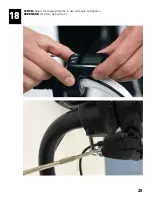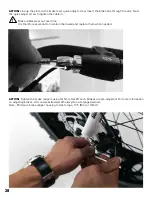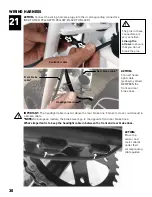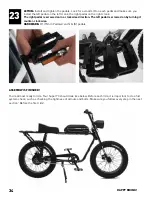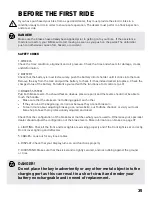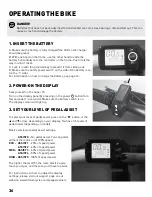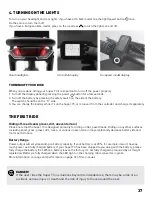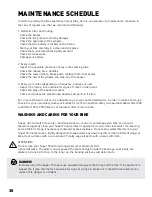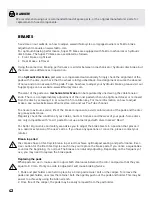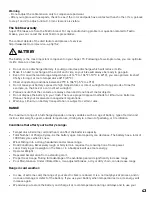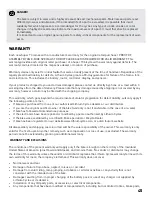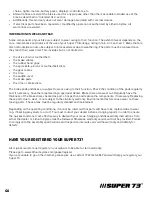
39
GENERAL WARNINGS
Like any sport, cycling involves risk of injury and damage. By choosing to ride a bicycle,
you assume the responsibility for that risk. You need to know and practice the rules and
safety regulations of riding this bicycle. Proper use and maintenance of your bicycle
reduces risk of injury.
Check your local state or country regulations for electric bike laws. For example, check
the minimum age for using an electric bike as this differs in various regions.
Riders must have the physical condition, reaction time and mental capability to ride
and manage traffic, road conditions, and sudden situations. Also, respect the laws
governing E-bike use with accordance to each region. If you have an impairment or
disability (i.e. visual impairment, hearing impairment, physical impairment, cognitive/
language impairment, seizure disorder, etc.), consult your physician before riding any
bicycle.
NOTICE:
It is recommended that users pay special attention to all of the general
operating rules below before operating their Super 73 bike.
•
When riding, obey the same road laws as all other road vehicles, including giving
way to pedestrians and stopping at red lights and stop signs.
•
For additional information, contact the road traffic authority, police department or Department of
Motor Vehicles in your state or country.
•
Use correct hand signals to indicate turning or stopping.
•
Concentrate on the path ahead. Avoid potholes, gravel, wet or oily roads, curbs, train tracks, speed
bumps, drain gates, and other obstacles.
•
Walk your bike across all train tracks
•
Expect the unexpected, such as opening car doors or cars backing out of driveways.
•
Be aware at intersections and when preparing to pass other vehicles or other cyclists.
•
Familiarize yourself with all the bike features. Practice using the brakes and power system.
•
If you are wearing loose pants, secure the bottom using leg clips or elastic bands to prevent them
from being caught in the chain or gears.
•
Wear proper riding clothes and avoid wearing open toe shoes.
•
Don’t carry passengers or cargo that will interfere with your ability to control the bicycle.
•
Don’t use items that may restrict your hearing.
•
Maintain a comfortable stopping distance from all other objects, riders, and vehicles. Safe braking
distances are based on forces, such as weather and light conditions among other variables.
WET WEATHER
It is recommended to not ride in wet weather. The Super 73 is not meant for use in puddles, heavy rain, and
streams. Never immerse this product in water as the electrical system may be damaged. Take extra care
while riding in wet conditions. Feet or hands can slip in wet conditions and lead to death or serious injury
from a fall. Brake earlier as it will take longer to slow than when operated in dry conditions. Decrease
riding speed. Wear reflective clothing and use approved safety lights. Road hazards are more difficult to
see when wet, proceed with caution.
RIDING AT NIGHT
Be safe! It is recommended to not ride at night. Ensure your Super 73 is equipped with a full set of
correctly positioned and clean reflectors. Use a properly functioning lighting set comprised of a white
front lamp and red rear lamp. Wear reflective and light colored clothing. Slow down and use familiar
roads with street lighting, if possible.
!
!
!
!
Users legs
should be at
least 24”/61
cm long to
ride the Super
73.

